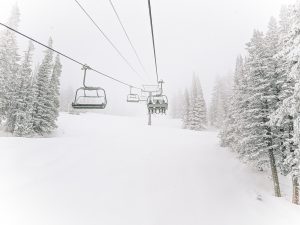Need an altitude adjustment? The town of Steamboat is located 6,900 feet above sea level – and Steamboat resort rises to more than 10,000 feet in altitude. That’s almost 2 miles above sea level!
Guests coming from lower elevations may take a little while to get used to this change, and also may experience altitude sickness. Essentially, what this means is that the air is thinner and less oxygen is available, causing some to experience some sickness related to being in higher elevation. This usually occurs within the first few hours upon arrival and can last up to 48 hours, or in some cases even longer. These symptoms may include headache, dizziness, nausea, sleep problems, loss of appetite, coughing and/or difficulty breathing, and general fatigue. Read through to learn how to alleviate symptoms of altitude sickness, and make the most out of your vacation in Ski Town U.S.A.!
WHAT IS HIGH ALTITUDE?
HIGH ALTITUDE IS DEFINED AS:
To learn more about the symptoms of Altitude Sickness, CLICK HERE.
THE CLASSIC SCENARIO
You fly from New York City to Denver at 5,000 feet. That afternoon you rent a car and drive up to Steamboat at 6,900 feet. You go out to dinner, have 3 or 4 drinks, go to bed, wake up early and hit the slopes. Upon waking, you have a cup of coffee and a bite to eat, and head to the Gondola. You go all the way up to the top of Storm Peak Express and head over to Morningside, hitting a whopping 10,568 feet in elevation! You ski all day, then celebrate your achievements with an après drink or two. Then, suddenly, you begin to have a severe headache and feel nauseous and weak. If this condition persists or worsens, you may find it difficult to ski, and just ruined your vacation.
Scenarios like this are not uncommon, so it’s essential that you understand the physiological effects of high altitude on your body. The best remedy to avoid altitude sickness is to follow a few basic rules when you arrive to Steamboat Springs.
HOW TO AVOID ALTITUDE SICKNESS
1. TAKE YOUR TIME
Consider spending a day or two in Denver or another town on the way before heading up to Steamboat. Or, if you fly directly into Hayden, spend a day walking around town before heading up to the slopes. Just one day at 5,000 – 6,000 feet can help tremendously in helping your body adjust a bit before you go up to 10,000 feet.
2. WATER IS YOUR FRIEND
Hydrate and refuel regularly (not just at lunch!) Be sure to drink a ton of water when you arrive to ensure you are well hydrated at higher altitudes. If you do not drink enough water, you may bring on a headache which is associated with altitude sickness. By drinking lots of water, even though you may not be thirsty, you may help alleviate future headache issues. Make sure that you do not drink alcohol instead of water, as alcohol can also bring on altitude sickness. Always remember: Water is your friend!
3. EAT RIGHT
It is important to eat a balanced diet to avoid altitude sickness, and that means consuming complex carbs (sorry KETO!) Complex carbs actually require less oxygen to metabolize and help you burn off a better ratio of oxygen to carbon dioxide, allowing you to use oxygen more efficiently. Plus, carbohydrates will help maintain your energy level and the protein will help rebuild muscle. You’ll appreciate that plate of pasta a little bit more the next day on the mountain!
4. DRY CLIMATE = DRY SKIN
When you come to Colorado, you will immediately notice that your skin may seem drier than at home. The high altitude sun and low humidity are surely to blame. Be sure to bring lotion and lip balm for a more comfortable and itch free vacation.
Local’s Tip: Head to Lyon’s Drug in downtown Steamboat to pick up any and all lotions & lip balms. They have a variety of locally sourced choices that are designed for high altitude living. Plus, the old-fashioned soda shoppe inside is the best for root beer floats and sundaes!
5. BLOCK THE SUN
Along with the high altitude comes intense sun beams and those damaging UV rays. Ultraviolet rays are more powerful at Steamboat’s higher elevation. Regardless of your skin color or complexion, it is important to wear a protective sunscreen even on overcast days when ultraviolet rays can penetrate cloud cover. Be sure to use sunscreen lavishly and we recommend 30 SPF.
Local’s Tip: Re-apply sunscreen often! Really!
6. BREAK OUT THOSE SHADES
A good pair of goggles or sunglasses that not only cut glare, but also filter out the damaging ultraviolet rays, are strongly recommended. Snow blindness, or photokeratitis, is temporary eye pain and discomfort after exposure to too much ultraviolet (UV) light. Snowblindness is not usually serious, however it is extremely uncomfortable and can feel like a sunburn on your eyes. Goggles and sunglasses are not just for looking cool in the mountains, guys! Goggles actually offer very important protection for your eyes from the damaging UV radiation. The UV radiation in the mountains is 36% higher than found at sea level. Wear your shades to protect your eyes from the glaring sun as it reflects off the snow, and look cool while doing it.
7. DRESS SMART
Bring layers of clothing as the temperatures will vary greatly from morning to evening in Steamboat. It’s not unusual to have a cool morning of 35 degrees and later in the day have it warm up to 80 degrees. The best clothing choice is water-resistant, layered clothing which can be removed or added with weather changes. Be sure to wear appropriate gloves, and a good helmet, especially on cold days to protect against frostbite. Remember, Steamboat’s weather can change day-to-day or even hour-to-hour, so be prepared for any type of weather condition.
8. STAY SAFE OUT THERE!
Altitude sickness is usually a minor problem, and can be treated with a good night’s sleep and plenty of water. However, symptoms can be more severe person to person. If symptoms persist, you should absolutely seek medical attention. High elevation can accentuate existing health problems, and cause pre-existing issues to worsen. If you have a respiratory or vascular illness, consult your doctor before your trip. If on the mountain, call Ski Patrol (970) 871-5911 for evaluation and assistance.
For local medical support, visit The Yampa Valley Medical Center 970-879-1322 – YVMC provides care 24 hours a day including emergency services, labs, respiratory therapy, family practice, sports medicine, and more. For more information visit www.yvmc.org.
Come Stay With Steamboat Lodging Company!
For more info about Steamboat Springs, CO check out these other great resources:
- Steamboat Lift Tickets & Passes
- 11 Things To Do in Steamboat Off the Slopes!
- Top 15 Restaurants in Steamboat Springs



